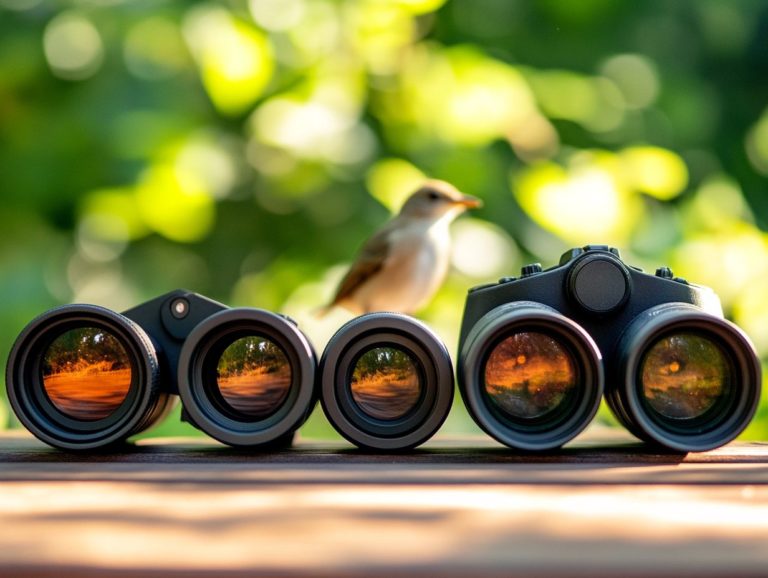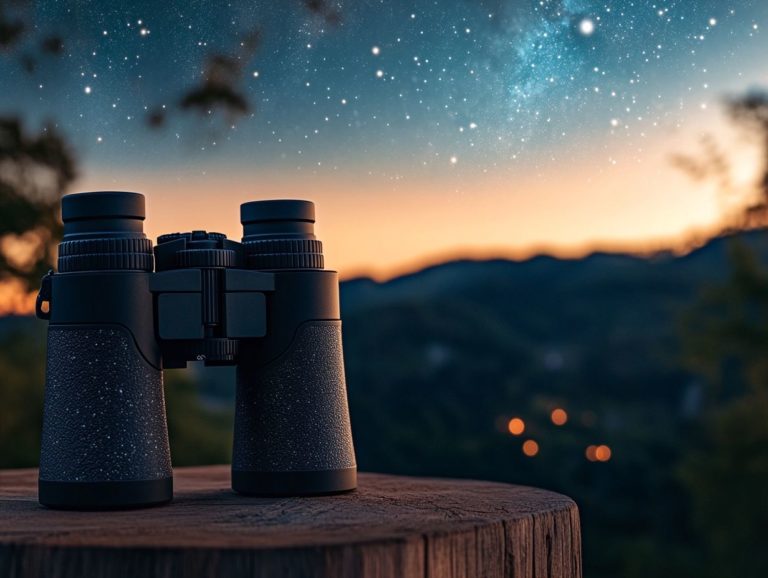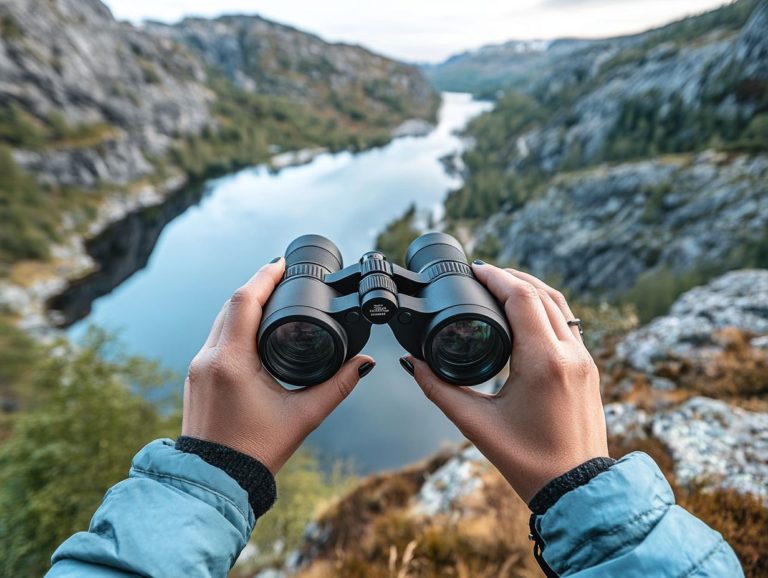Understanding the Importance of Binoculars in Birding
Birding is an exciting adventure that connects you with nature. It offers a unique perspective on the intricate world of avian life.
Having the right tools is important to truly appreciate the beauty and complexities of birds. This guide explains why binoculars are key for birdwatchers, highlighting their advantages and limitations.
You will discover various types of binoculars, important features to consider, and tips for keeping them in great condition.
Contents
Key Takeaways:
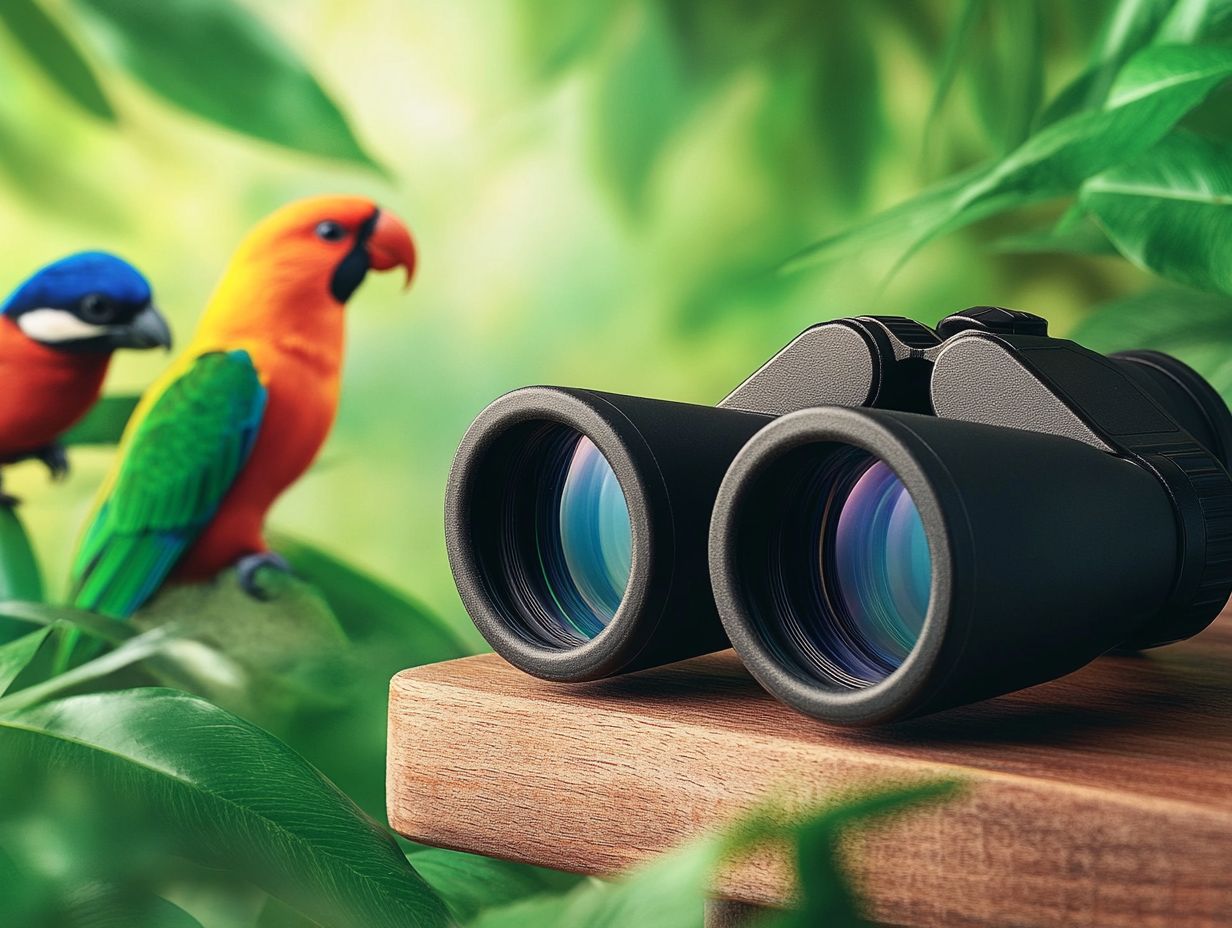
- Binoculars are essential for birding as they allow for a closer and more detailed view of birds, improving your experience, particularly when considering binocular specifications.
- There are various types of binoculars available for birding, each with its own set of features, pros, and cons. It’s important to choose the right one for your specific needs.
- Proper maintenance and care of binoculars is crucial to ensure their longevity and optimal performance, including regular cleaning and proper storage techniques.
What is Birding?
Birding, often referred to as birdwatching, is an enchanting outdoor pursuit that invites you to observe and identify a myriad of bird species in their natural habitats. As you embrace this hobby, you’ll find yourself using binoculars that enhance your experience, allowing you to appreciate intricate details of plumage, behavior, and calls.
From the elusive Kirtland’s Warbler to breathtaking performances during birding festivals, birding is more than just observation; it’s a rich tapestry of activities. You might photograph avian wonders, join local bird counts, or participate in field trips organized by wildlife groups, each opportunity deepening your connection to nature.
If you re captivated by the remarkable diversity of birds whether it s raptors gliding majestically overhead or vibrant songbirds dancing among the branches you’ll soon realize that having the right gear is crucial. Top-notch spotting scopes and field guides can significantly enhance your experience.
Organizations such as the National Audubon Society play an invaluable role in fostering a community around birding. They promote conservation initiatives and provide resources for both novice and seasoned birders, cultivating a shared passion for avian life.
Why Binoculars are Essential for Birding
Binoculars are an essential companion for any birding enthusiast, transforming your experience of observing avian species in their natural habitat. They enrich your birdwatching by providing a wide field of view and excellent light transmission. Knowing what to look for when buying birding binoculars can help you choose the right pair for clear images.
Whether you re tracking a distant hawk soaring overhead or observing a nesting warbler nearby, investing in a high-quality pair of binoculars like the Nikon Monarch M7 or Zeiss can significantly enhance your ability to connect with nature and appreciate a variety of species.
Advantages of Using Binoculars
Using high-quality binoculars for birding offers numerous advantages that can elevate your birdwatching experience. With impressive magnification power, these binoculars enable you to spot distant birds with crystal clarity.
Their close focus capabilities allow you to observe smaller species up close, resulting in sharp images that capture essential details for identification. Features like adjustable eyepieces and weatherproofing enhance your adventures, making them essential tools for maximizing outdoor time.
Advanced optics ensure vibrant color reproduction and contrast, vital for distinguishing similar species. Adjustable eyepieces cater to various users, providing comfortable viewing whether you wear glasses or not.
Many models are designed to be lightweight, making them easy to carry during long hikes or birdwatching excursions. With weatherproofing features, you can continue your pursuits even on drizzly days.
High-quality binoculars bring an exhilarating edge to your birdwatching adventures and deepen your appreciation for the wonders of nature.
Limitations of Not Using Binoculars

Not using binoculars can significantly limit your birding experience and hinder your ability to observe and identify various bird species. Without sharp images and an enhanced field of view, you may struggle to notice subtle details like plumage variations or behavioral traits crucial for accurate identification.
Attempting to observe birds without the right optics leads to missed opportunities, resulting in frustration and a less fulfilling connection to nature.
Many enthusiasts find themselves watching from a distance, squinting to catch fleeting glimpses of birds. This approach diminishes the joy of spotting rare species, turning identification into a guessing game rather than an exciting adventure.
Lacking close-up views can make local birding events feel less rewarding for those without proper gear. Techniques like tracking and cataloging bird behaviors become cumbersome, limiting the ability to appreciate the rich diversity of avian life.
Relying solely on unaided vision detracts from the immersive moments that define birding as a cherished pastime, leaving you with fewer opportunities to witness the beauty of species like the Kirtlands Warbler.
Types of Binoculars for Birding
There s a world of binoculars designed specifically for birding, each tailored to meet distinct observation needs. From compact models that enhance portability for travel to larger versions with porro and roof prism designs, the right binoculars depend on your preferences and conditions.
Renowned brands like Nikon Monarch M7, Zeiss, and Swarovski offer exceptional optics, providing clear and vibrant images essential for effective birdwatching. Explore these models to find the perfect fit for your adventures!
Features to Consider
When selecting binoculars for birding, consider several key features to enhance your experience. The field of view is essential for tracking swift-moving birds, while magnification power impacts how close your subject appears.
Pay attention to the exit pupil, which affects brightness in low-light conditions, and ensure eye relief for comfort during lengthy observations. Understanding these features empowers you to make informed decisions when choosing the ideal binoculars.
Also, consider weight and build quality, as they greatly affect usability and durability. A lightweight design makes handling a breeze during extended outings, while rugged materials provide peace of mind against the elements.
Lens coatings enhance image clarity and minimize glare, ensuring that the joy of birding remains uncompromised. Thoughtfully considering these features will help you discover binoculars tailor-made for your unique birdwatching style.
Pros and Cons of Different Types
Each type of binoculars for birding presents its own unique set of advantages and disadvantages. This influences your decision-making process as an avid birder.
Compact binoculars are lightweight and easily portable, making them perfect for travel. However, they might sacrifice some magnification power compared to larger models.
Porro prism binoculars often deliver superior depth perception and a wider field of view. In contrast, roof prism designs offer sleek, compact convenience.
Brands like Vortex and Opticron cater to various preferences, ensuring you can find the perfect balance that suits your style and needs.
If you prioritize durability, look for waterproof options. These allow you to birdwatch in different weather conditions definitely a leg up compared to standard models.
Just keep in mind that these rugged builds can sometimes be heavier. This may not sit well with casual birders.
The optical quality can also vary quite a bit. Higher-end models often have special coatings. These coatings help improve visibility by allowing more light to pass through.
Taking the time to compare these different designs highlights the unique benefits and drawbacks each one offers. This gives you the power to make an informed choice tailored to your specific birdwatching adventures.
How to Choose the Right Binoculars for Birding
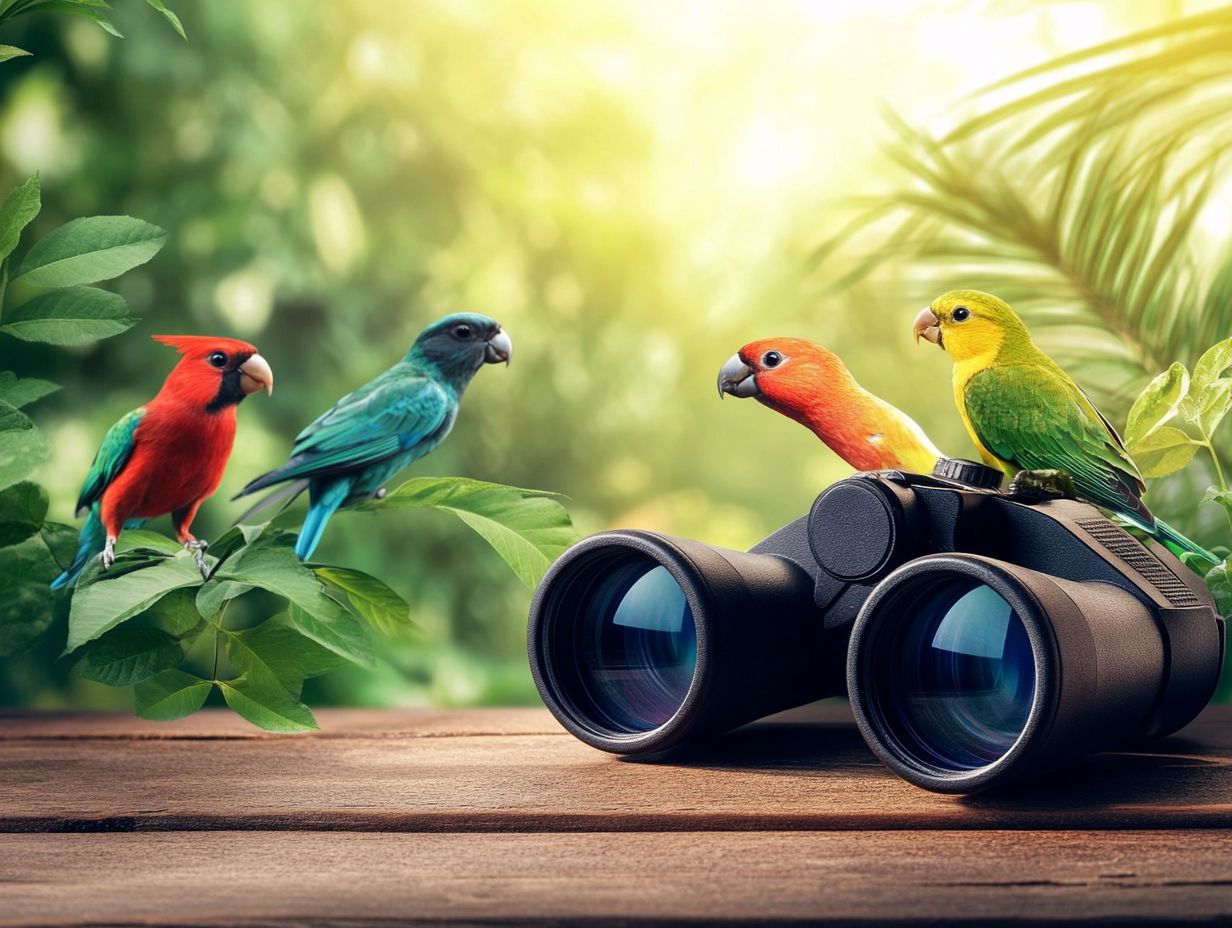
Choosing the right binoculars can make your birdwatching trips unforgettable! It’s essential to assess your specific requirements. Think about whether you need enhanced magnification for distant sightings or a model better suited for close-range observations.
Consider weight and durability as well. With countless options available, prioritize features that resonate with your unique birding style and preferences.
This way, you can make an informed decision that elevates your outdoor adventures to new heights.
Tips for Selecting the Best Binoculars
Selecting the finest binoculars for your birding adventures requires a thoughtful approach. Start by assessing the specifications that resonate with you, such as adjustable eyepieces for comfort and weatherproof features to withstand various outdoor conditions.
Conduct field tests with different models. This helps you discover which binoculars feel just right in your hands, ensuring a pleasurable birdwatching experience, no matter the weather.
Pay careful attention to magnification and objective lens diameter. These factors directly impact light transmission and image clarity.
The weight of the binoculars also plays a significant role. A lightweight option can transform those long birdwatching sessions into sheer enjoyment, sparing you from unnecessary strain.
Look for features like image stabilization and lens coatings. They can significantly improve your viewing experience.
If you wear glasses, be sure to try the binoculars on while doing so. This can influence both comfort and usability.
By taking a hands-on approach, you can confidently select the perfect pair tailored to your unique birdwatching style.
Maintaining and Caring for Binoculars
Maintaining and caring for your binoculars is crucial to keep them in peak condition. This ensures they deliver exceptional optical performance during your birdwatching excursions.
Regular cleaning with the right techniques prevents dirt and smudges from clouding your view. This ensures that the lenses provide a bright and clear image.
Additionally, using effective storage methods and binocular straps protects your investment. This allows for easy access while safeguarding against potential damage during your adventures in diverse environments.
What do you want to see clearly? A distant eagle or a nearby hummingbird? Start exploring your options today and find the perfect binoculars that suit your needs!
Proper Cleaning and Storage Techniques
To maintain the visual performance of your binoculars, it s essential to adopt proper cleaning and storage techniques that ensure a bright image and longevity.
Cleaning the lenses with suitable materials, such as microfiber cloths and dedicated lens cleaners, allows you to remove dust and smudges without risking scratches.
Storing your binoculars in protective cases and using binocular straps during transport can prevent damage and preserve the quality of the view, ensuring they re always ready for your next birding adventure.
Regularly inspecting your binoculars is crucial, as moisture or dirt accumulation can impact their effectiveness. A lens brush can help dislodge stubborn particles, while an air blower works wonders for removing dust from hard-to-reach areas.
If you love the great outdoors, choose water-resistant models to provide extra protection against the elements.
Investing in a solid, padded case not only secures your binoculars but also minimizes the risk of scratches and impacts.
These simple steps will keep your binoculars in top shape, contributing to their clarity and functionality, making each viewing experience even more enjoyable.
Frequently Asked Questions

What is the importance of binoculars in birding?
Binoculars are essential tools for birding because they allow you to see birds in detail from a distance. Knowing why waterproof binoculars matter for bird watchers can enhance your experience, as they provide a clear and magnified view, making it easier to identify and observe birds in their natural habitat.
How do binoculars enhance the birding experience?
Binoculars let birders see small and distant birds that may not be visible to the naked eye. They also help identify key features of a bird’s appearance, behavior, and plumage, making the birding experience more fulfilling and enjoyable.
What features make good birding binoculars?
- Magnification of at least 8x to 10x
- Lens size of 42mm or larger
- Wide field of view
- Lightweight and waterproof for durability
Can I use any type of binoculars for birding?
While any binoculars can be used for birding, it is recommended to use models specifically designed for this activity. Birding binoculars have features such as close focus, a wide field of view, and high magnification, which are essential for observing birds in their environment.
Why are binoculars important for bird conservation?
Binoculars play a vital role in bird conservation as they allow birders to observe and document bird species in their natural habitat. To choose the right tools for this purpose, it’s important to understand what makes a great pair of bird watching binoculars. This information is crucial for researchers and conservationists to monitor bird populations and protect their habitats.
How do I take care of my binoculars for birding?
To ensure your binoculars last, keep them in a protective case when not in use. Avoid dropping them or exposing them to extreme temperatures, and clean them regularly with a soft cloth. It s also wise to have them serviced by a professional every few years for optimal performance.
Invest in quality binoculars today and enjoy the wonders of birdwatching!

